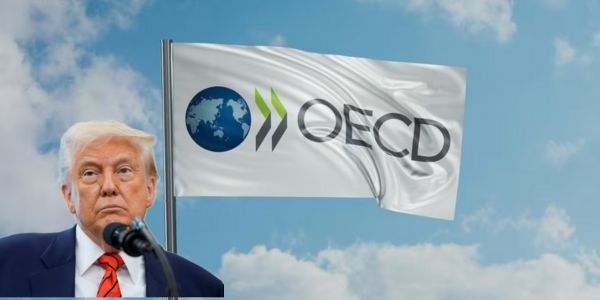OECD slashes global growth forecasts for 2025-2026, citing escalating US trade tariffs under Trump. Discover how rising protectionism impacts the global economy, inflation, and business. Read more on The Interview Times.
The global economic outlook has taken a somber turn as the Organisation for Economic Co-operation and Development (OECD) announced significant downgrades to its growth forecasts for 2025 and 2026. The grim prognosis, detailed in the latest OECD Economic Outlook report, attributes the slowdown primarily to the escalating trade tensions fueled by US President Donald Trump’s aggressive tariff policies.
The Paris-based intergovernmental economic organization now projects global economic growth to be a mere 2.9% for both 2025 and 2026. This marks a notable reduction from earlier estimates of 3.1% and 3.0%, respectively. The revised figures underscore a growing concern among international economists that protectionist measures are beginning to bite, threatening to stifle global commerce and investment.
US Economy at the Forefront of the Downturn
The United States, the world’s largest economy, is expected to bear a significant brunt of these policies. The OECD’s revised forecast for US growth now stands at a modest 1.6% for 2025 (down from 2.2%) and a further slowdown to 1.5% in 2026. This deceleration is directly linked to the “substantial increases” in trade barriers and the pervasive policy uncertainty, according to the report.
“We have seen a significant increase in trade barriers as well as in economic and trade policy uncertainty,” stated Álvaro Pereira, OECD Chief Economist, in an accompanying commentary. “This sharp rise in uncertainty has negatively impacted business and consumer confidence and is set to hold back trade and investment.”
Must Read: RBA Cuts Interest Rates to 3.85% as Trade Tensions Mount
Tariffs Fuel Inflation and Disrupt Supply Chains
The report highlights a concerning surge in the effective tariff rate on US merchandise imports, which has soared to 15.4% – the highest level since 1938. The OECD warns that these tariffs will “dent household consumption and business investment growth” within the US and are expected to contribute to rising inflation. US inflation is now projected to reach nearly 4% by the end of 2025, double the Federal Reserve’s target.
This inflationary pressure is not confined to the US. While G20 inflation is broadly expected to moderate, the impact of higher trade costs in tariff-raising countries is anticipated to push up overall prices.
Global Ripple Effect
The negative repercussions of the ongoing trade disputes are projected to spread far and wide. China, the world’s second-largest economy, has also seen its growth forecast slightly trimmed. Japan’s outlook has been downgraded as well. Although the Eurozone’s growth forecast remains stable, the OECD cautions that “lower growth and less trade will hit incomes and slow job growth” across the globe, with almost no exception.
Must Read: Understanding the Sustainable Development Goals: A Blueprint for a Better Future
Call for Cooperation
In light of the worsening outlook, the OECD’s chief economist, Álvaro Pereira, stressed the critical need for international cooperation. He urged countries to “sit down and get an agreement” to avert further trade fragmentation, emphasizing that avoiding such divisions is “absolutely key in the next few months.”
The OECD’s stark assessment serves as a powerful reminder of the interconnectedness of the global economy and the far-reaching consequences of protectionist trade policies. Businesses and consumers worldwide will be closely watching for any signs of de-escalation that could alleviate the mounting economic pressures.

